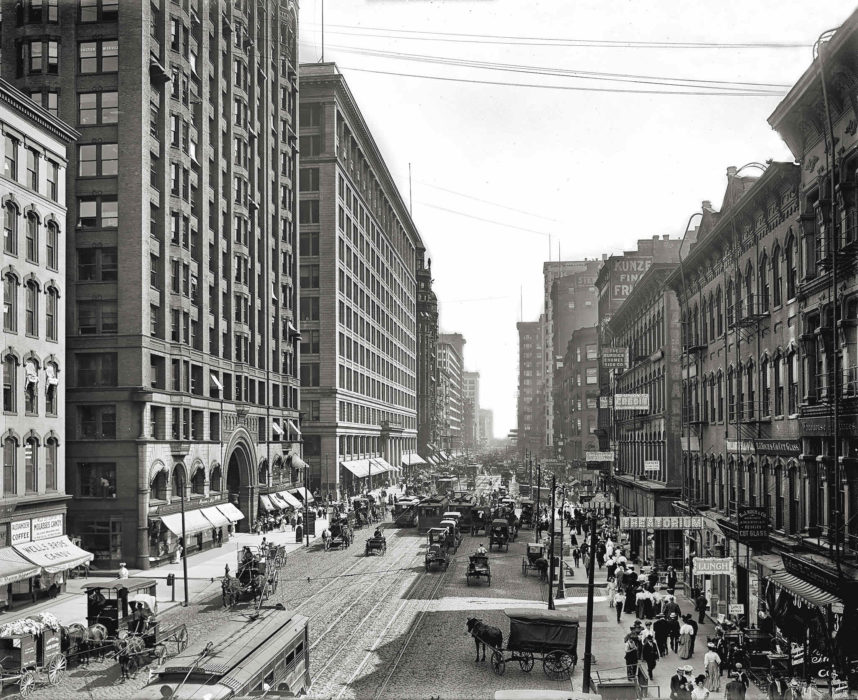THE RACE RIOT in Springfield, Illinois, on August 14, 1908, changed forever the public agenda for colored people in the United States of America. Beginning early in the evening, a mob of several thousand white Springfield citizens “proceeded hour after hour and on two days in succession to make deadly assaults on every Negro they could lay their hands on, to sack and plunder their houses and stores, and to burn and murder on favorable occasion.”
William English Walling, who wrote the account, and his wife arrived in Springfield the next morning. He registered his shock in an article in The Independent on September 3. “We at once discovered, to our amazement,” he wrote, “that Springfield had no shame. She stood for the action of the mob. . . . I talked to many of them the day after the massacre and found no difference of opinion in the question, ‘Why, the niggers came to think they were as good as we are!’ was the final justification offered, not once, but a dozen times.”
Before the Springfield Race Riot, most Americans had believed that large-scale race violence was a purely Southern phenomenon, confined to backwaters like Atlanta, or Wilmington, North Carolina. In fact, there had been several anti-black confrontations in the North, but the Springfield Riot shocked and disgraced the nation because it had occurred just four city blocks from Abraham Lincoln’s home. Springfield galvanized — at last — the national movement for Negro rights.
Soon Walling, who was a Socialist, and several white friends founded the National Association for the Advancement of Colored People (NAACP), a nationwide, biracial organization that would fight to achieve African American civil rights for the next fifty years. Many years later, Walling shared his own version of this history: “I always date the real launching of the organization,” he wrote, “from the day we secured Dr. Du Bois.” W. E. B. Du Bois resigned his teaching position at Atlanta University to become the NAACP’s publicity director and editor of The Crisis, the organization’s official publication.

Three and a half years later, the NAACP invited ‘Abdu’l-Bahá to address their Fourth Annual Conference in Chicago. He spoke at the conference twice on Tuesday, April 30, 1912, once early in the afternoon at Hull House in South Chicago and then to the evening session at Handel Hall, at 40 East Randolph Street in the Loop neighborhood. Du Bois had named ‘Abdu’l-Bahá one of The Crisis’s “Men of the Month” for May.
‘Abdu’l-Bahá began his address at Handel Hall by quoting the Old Testament: “Let us make man in our image, after our likeness.” “Let us find out,” he proposed, “just where and how he is the image and likeness of the Lord, and what is the standard or criterion whereby he can be measured.”
Then he asked a series of rhetorical questions: “If a man should possess wealth, can we call him an image and likeness of God? Or is human honor the criterion whereby he can be called the image of God? Or can we apply a color test as a criterion, and say such and such an one is colored a certain hue and he is therefore, in the image of God? Can we say, for example, that a man who is green in hue is an image of God?”
“Hence we come to the conclusion that colors are of no importance. Colors are accidental in nature. . . . Let him be blue in color, or white, or green, or brown, that matters not! Man is not to be pronounced man simply because of bodily attributes. Man is to be judged according to his intelligence and spirit. . . . That is the image of God.”
‘Abdu’l-Bahá concluded by once again conflating and neutralizing common uses of the imagery of black and white, as he had done in Washington: “If man’s temperament be white, if his heart be white, let his outer skin be black; if his heart be black and his temperament be black, let him be blond, it is of no importance.” Color, in other words, had no effect on the content of a person’s character.

Next dooor to Handel Hall, at the Masonic Temple on the corner of State and Randolph Streets, another convention was underway that evening. Fifty-eight delegates from forty-three cities were about to elect nine members to the governing board of the Bahá’í Temple Unity, a national body formed to coordinate the largest project ever undertaken by the Bahá’ís in North America: the construction of an enormous house of worship north of Chicago. White fluted columns with capitals wrapped in acanthus leaves surrounded the delegates in Corinthian Hall as they cast their secret ballots.
After the first round of voting there was a tie for ninth place between Frederick Nutt, a white doctor from Chicago, and Louis Gregory, the black lawyer from Washington, DC. In a dramatic departure from the vicious 1912 Presidential election, which raged all around them, each man resigned in favor of the other.
Then Mr. Roy Wilhelm, a delegate from Ithaca, NY, stood and put forward a proposal. His motion, seconded by Dr. Homer S. Harper of Minneapolis, recommended that the convention accept Dr. Nutt’s resignation.
The delegates assented unanimously.
To have elected an African American to the governing board of a national organization of largely middle- and upper-class white Americans — and to have done so at the nadir of the Jim Crow era in 1912 — was rare in the extreme. Even the NAACP had only elected one black member to its executive committee when it had been formed in 1909.
‘Abdu’l-Bahá’s assault on the color line was beginning to bear fruit.






